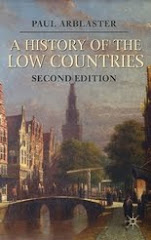The fourth chapter of this much-reprinted early-modern phrasebook is entitled “For to aske the way: With other familiar communications.” The English version of the chapter runs as follows (quoted here from the Liège, 1610 edition, which is neither the first nor the last, with obvious misprints corrected but otherwise in the original spelling):
A. God save you maister Robert.
B. Sir, God geeve you a good life.
A. How doth your health, since I sawe you?
B. So so.
A. Me thincketh that yo doo not so well as you were wont.
B. How knowe you that?
A. By your face which is so pale.
B. I have had five or six fittes of an ague, which have much
weakened mee, and have taken away all my stomack.
A. It is an evell sicknesse. Whither ride you so sely?
B. To Antwerp, to the Sinxson* fayre.
A. And I also: if you wil, we will go together.
B. It pleaseth mee very well, but you ride a little too fast
for mee.
A. Let us ride as you will, it is all one for mee, for my
horse ambleth very easely.
B. And mine doth trot to hard. Now let us ryde in Gods name:
what folke be they that do go before us?
A. I knowe them not trulye, they be marchants: let us pricke
our horses for to overtake them, for I am afrayde that wee be out of our way.
B. We be not, be not afrayde.
A. Yet it is good to aske it.
B. Aske of that shee sheapherd.
A. My shee freend, where is the right way from hence to
Anwerp?
C. Right before you, turning nether on the righte nor on the
left hand, till you come to an high elme tree, then turne on the left hand.
A. How many miles have we from hence to
the next village?
C. Two miles and a half, and a little
more.
A. Now let us go at leasure, for I am out of doubt: I see
the tree wherof shee hath tolde us. It is very dustie, the dust doth put out my
eyes.
B. Take this taffeta to put before your face, and it will
keepe you from the dust, and from the sunne.
A. It is no neede, for the sunne goeth downe: I am afraide
that we shall not come by day light to the towne.
B. Yes forsooth. But the worst is, that this way is daungerous
because of theeves, they did rob thother day a riche marchant hard by this tree,
the which maketh mee afrayde to be robbed, except wee take heede.
A. I see the steeple of the towne, except I be deceaved.
B. Truly, it will be late before wee come thether. I doubt,
that wee shall not get in.
A. Yes forsooth, they do not shut the gates before nyne of
the clock.
B. It is the better
for I would not lie gladly in the suburbs.
A. Nor I too.
B. Let us aske of these folks for the best inne of this
towne.
A. Take no care for that, I know well the best lodging of
the towne, it is in the red lion in the camerstrate. Let us make hast I pray
you, for mee thinke they take upp the drawbridge.
B. I am so weery that I can not go any farder, and moreover
my horse halteth, I do thinke that a naile doth pricke him, or hee is hurt upon
the backe and then this cawsie** is so hard, that it bruseth mee altogether.
A. Let us ride in then.
.jpg)

